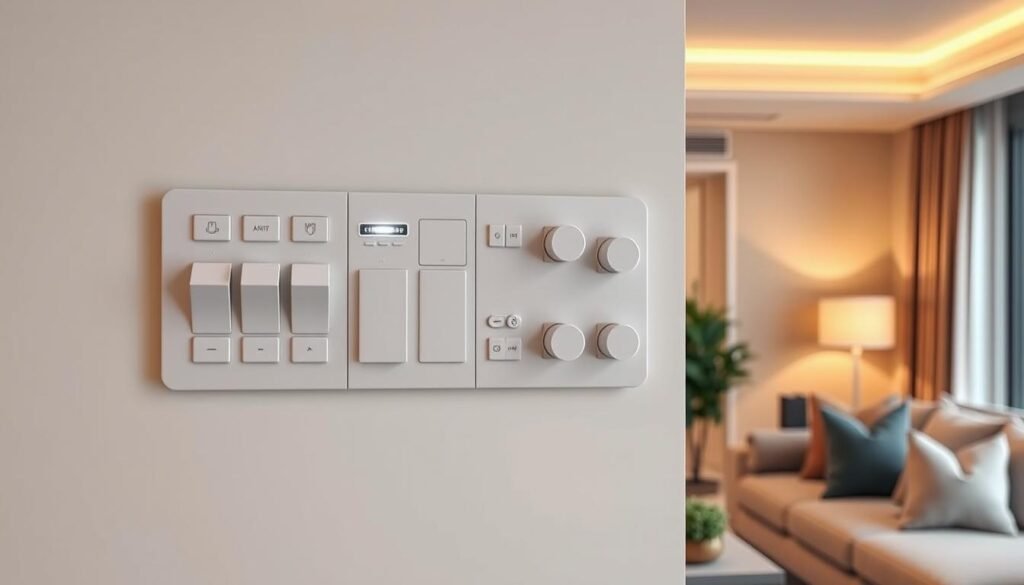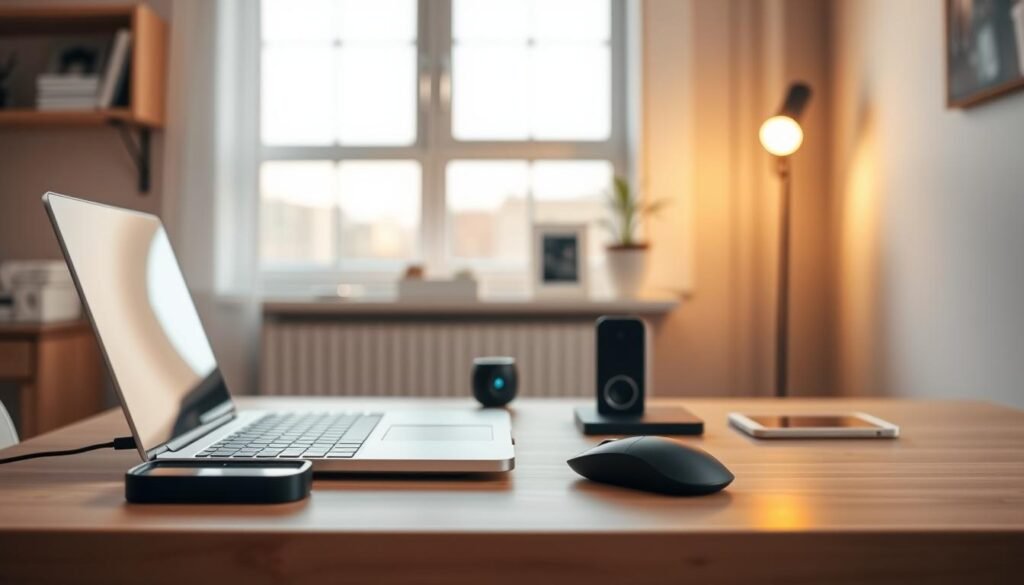Did you know making your home more energy-efficient can save you hundreds of dollars a year? Simple changes can cut down your energy use. They also make your home more comfortable.
Boosting energy efficiency in your home lowers your bills and helps the planet. This article will show you easy ways to save energy. These tips can really make a difference.
Key Takeaways
- Simple changes can significantly reduce energy consumption.
- Energy-efficient homes are more comfortable and cost-effective.
- Implementing energy-saving strategies benefits both your wallet and the environment.
- Energy Star certified products can help you save energy.
- Practical tips will be provided to boost your home’s energy efficiency.
The Impact of Energy Consumption on Your Home
Energy use in your home affects your money and the planet. Homes use a lot of energy. Knowing how much you use is important to save and be more efficient.
Common Energy Drains in American Homes
Many homes in the U.S. have energy problems. These problems make bills go up and harm the environment. Some big energy drains are:
- Inadequate insulation and sealing, leading to heat loss in winter and heat gain in summer.
- Inefficient appliances and lighting that consume more energy than necessary.
- Poorly maintained heating and cooling systems that work harder than needed.
Financial and Environmental Benefits of Energy Efficiency
Being energy efficient at home saves money and helps the planet. By using less energy, you can:
- Lower your utility bills, saving money on heating, cooling, and electricity.
- Reduce your environmental impact by cutting down on greenhouse gas emissions.
- Make your home more comfortable and valuable with better insulation and climate control.
Half of all household energy use is for heating and cooling. Sealing and insulating can make your home more efficient and cozy.
Energy-Saving Tips for Home: A Comprehensive Guide
Make your home cozy and cut down on energy use. Simple changes can help the planet and save you money on bills.
Quick Wins for Immediate Energy Reduction
Fix leaky faucets and seal drafty windows first. Switch to energy-saving bulbs and turn off unused appliances. These steps can really help.
Seasonal Adjustments to Save Energy
Change your ways with the seasons. Close curtains in summer to keep it cool. This cuts down on air conditioning needs.
Creating Energy-Saving Habits
Make doing laundry in cold water a habit. Also, turn off lights when you leave a room. These habits save a lot of energy.
Optimizing Your Heating and Cooling Systems
It’s key to make your heating and cooling systems work better. A good system saves money and makes your home cozy.
Air Conditioner Efficiency Tips
To get the most from your air conditioner, change the filters often. A dirty filter can make it use more energy. Also, get a pro to clean the condenser coils every year.
- Use a programmable thermostat to control the temperature when you’re away.
- Keep your air conditioner in top shape for better efficiency.
Heating System Maintenance
Looking after your furnace is vital for saving energy. Even old furnaces can work better with yearly checks by a pro.
| Maintenance Task | Frequency | Benefit |
|---|---|---|
| Filter Replacement | Monthly | Improved Air Quality |
| Professional Servicing | Annually | Increased Efficiency |
Using Ceiling Fans to Circulate Air Effectively
Ceiling fans help move air, making your home cooler in summer and warmer in winter. This lets you lower your thermostat, saving energy.
By following these tips, you can make your heating and cooling systems more efficient. This leads to a greener, more energy-saving home.
Smart Thermostat Solutions
Getting a smart thermostat is a smart move for your home. It can cut your heating and cooling costs by up to 15%. It learns your habits and changes the temperature for you.
Benefits of Programmable Thermostats
Programmable thermostats are great because they adjust the temperature for you. They save energy when you’re not home or sleeping. Experts say they can lower your energy bills.
This automation makes your home more comfortable and saves a lot of energy.
Setting Up Temperature Schedules
Setting up your smart thermostat is easy. Most have simple interfaces to help you set a schedule. You can make it lower the temperature when you’re away or asleep.
This way, you save energy and stay comfortable. It’s a win-win for your home and the planet.
Water Heating Efficiency Strategies
Improving water heating efficiency saves energy and lowers your bills. Water heaters use a lot of energy, making them key to save.
Adjusting the temperature and regular maintenance are simple ways to boost efficiency.
Water Heater Settings and Maintenance
Using a thermometer, set the water heater to 120 degrees Fahrenheit. This can cut 6% to 10% from your bill. Regular checks for leaks and flushing out sediment are also important.
Reducing Hot Water Usage Throughout Your Home
Changing daily habits can cut down hot water use. Use low-flow showerheads and faucets. Fix leaks fast and wash clothes in cold water.
| Strategy | Energy Savings | Implementation Ease |
|---|---|---|
| Adjust Water Heater Temperature | 6%-10% | Easy |
| Install Low-Flow Fixtures | Up to 20% | Moderate |
| Regular Maintenance | Variable | Easy to Moderate |
Lighting Solutions That Save Energy
Good lighting can cut down on energy use at home. Using energy-saving lights helps lower bills and helps the planet.
Energy-Efficient Light Bulb Options
Choosing the right light bulbs is easy. LEDs, for example, last much longer and use less power than old bulbs. They’re great for lights you use a lot.
| Light Bulb Type | Energy Consumption | Lifespan |
|---|---|---|
| Incandescent Bulbs | High | Short |
| LED Bulbs | Low | Long |
| Halogen Bulbs | Medium | Medium |
Smart Lighting Controls and Automation
Smart lighting lets you control your lights better. You can change brightness, set times, and even control them from afar. This stops lights from being on when not needed.

Smart lights save energy and make your home more comfy and easy to use.
Kitchen Appliance Energy-Saving Techniques
Making small changes to your kitchen can cut down your energy costs. By tweaking your fridge, freezer, dishwasher, and cooking ways, you can save a lot of energy.
Refrigerator and Freezer Optimization
To make your fridge and freezer better, check the seals. They should be tight and clean. Make sure the fridge is at 40°F (4°C) or below, and the freezer at 0°F (-18°C).
Defrosting your freezer often and keeping the coils clean also helps. This makes your fridge and freezer work better.
Dishwasher Efficiency and Using Cold Water Cycles
Using your dishwasher wisely saves water and energy. Always fill it up and use the cold water cycle if you can. Dishwashers made after 2011 are good at cleaning without pre-rinsing.
Only pre-rinse dishes if they’ll sit unwashed for hours. This saves water and energy.
| Dishwasher Feature | Energy Saving Tip |
|---|---|
| Energy-Saving Cycle | Use this cycle for lightly soiled dishes to save energy. |
| Cold Water Cycle | Washing with cold water reduces energy consumption. |
| Full Load Requirement | Running a full load maximizes efficiency per cycle. |
Energy-Efficient Cooking Methods
Choosing the right cooking methods can also save energy. Use the right-sized pots and pans for your burners. Covering pots when boiling or steaming helps too.
Using a microwave or toaster oven for small meals is another good idea. Keeping your oven clean and using the self-cleaning feature less often also helps.
Laundry Room Optimization
Optimizing your laundry room can cut down energy use. A few simple changes can make a big difference in your bills.
Washing Machine Efficiency: Wash Full Loads and Use Cold Water
Washing full loads and using cold water save a lot of energy. Energy Star says most energy use is from heating water. Modern soaps work well in cold water, so it’s a good choice for most loads.
- Wash full loads to maximize efficiency.
- Use cold water to reduce energy consumption.
Clothes Dryer Alternatives and Energy-Saving Tips
Looking for dryer alternatives and saving energy tips can help too. Try using a clothesline or drying rack when you can.
| Dryer Alternative | Energy Savings |
|---|---|
| Clothesline | High |
| Drying Rack | Medium |
| Heat Pump Dryer | High |
Tackling Phantom Power and Electronics Usage
Phantom power is a big deal for home energy use. Many devices use power even when off but plugged in.
Using Power Strips to Eliminate Standby Power
Power strips are a great way to cut down on standby power. Plug your devices like TVs and computers into them. Then, turn off the strip when not in use. This helps a lot with phantom power.
| Device | Average Standby Power (Watts) |
|---|---|
| TV | 5-10 |
| Computer | 2-5 |
| Home Theater System | 10-20 |
Choosing and Using Energy-Efficient Electronics
When buying new electronics, look for low standby power. Also, choose devices that are energy-efficient. Some are marked as “Energy Star” compliant, showing they meet energy standards.

Home Insulation and Weatherization Techniques
Improving your home’s energy use starts with insulation and weatherization. Sealing and insulating is a smart, cost-effective move. It makes your home more efficient and cozy. By fixing air leaks and adding insulation, you can cut down on energy use.
Identifying and Sealing Air Leaks
Air leaks around windows, doors, and openings waste a lot of energy. To find these leaks, try this: hold a lit incense stick or candle near gaps. If the flame dances or smoke goes to the gap, you’ve found a leak.
- Check around windows and doors for gaps.
- Inspect electrical outlets and switches.
- Look for leaks around plumbing and electrical penetrations.
Sealing these gaps with caulk or weatherstripping stops air from escaping. This boosts your home’s energy use.
Improving Insulation for Better Energy Efficiency
Good insulation keeps your home at a comfy temperature and saves energy. To boost insulation, follow these steps:
- Check the attic, walls, and floors for enough insulation.
- Add insulation if needed, making sure it meets your area’s R-values.
- Get a pro to check your insulation for a detailed review.
With better insulation, your home will be more energy-efficient and cozy.
Energy Star Appliances: Are They Worth the Investment?
Energy Star appliances use less energy than regular ones. They are good for people who want to save energy. This makes them a great choice for saving money and helping the planet.
Understanding Energy Star Ratings and Labels
Energy Star ratings show how energy-efficient appliances are. The U.S. Environmental Protection Agency (EPA) sets these standards. They keep getting better to help us save more energy.
- Look for the Energy Star label when buying new appliances.
- Check the appliance’s energy use with the EnergyGuide label.
- Think about the appliance’s features and if they fit your needs.
Long-Term Savings from Energy-Efficient Appliances
Buying Energy Star appliances can save you money over time. They use 10-20% less energy than regular ones. Plus, you might get rebates or incentives from your utility company or government.
Choosing Energy Star appliances helps lower your bills. It also helps our planet stay healthy.
Conclusion: Building a More Energy-Efficient Home
Making your home energy-efficient is smart for your wallet and the planet. You can use less energy, save money, and help the environment. This is a great way to live better.
Small changes can make a big difference. Try using energy-saving light bulbs and smart thermostats. You can also use less hot water and get Energy Star appliances.
Being energy-efficient doesn’t have to cost a lot. Simple steps like sealing leaks and using fans can help. Even washing clothes in cold water can save energy.
By making your home more energy-efficient, you save money and help the planet. Start today and enjoy a greener home.
